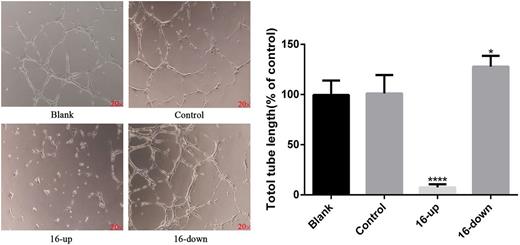Abstract
Background: As key factors in gene post-transcriptional regulation, microRNAs (miRNAs) have been identified to play important roles in carcinogenesis in various tumors. Myelodysplastic syndrome(MDS) is a group of clonal myeloid disorders characterized by refractory quantitative and qualitative abnormalities of hemocytes and its pathogenesis is poorly understood. Some studies have showed that abnormal expressions of some miRNAs have close relationship with the pathogenesis of MDS. Recently, high VEGF expression is found common in all kinds of myelodysplastic syndromes including patients but its mechanism remains unclear.
Methods The expression levels of miR-16 in RNA of normal controls, myelodysplastic syndrome (MDS) patients and cell lines including HL-60 cell, THP-1 cell, SKM-1 cell and K562 cell line were determined by qRT-PCR. The VEGF-secreted level in the serum of normal controls, MDS patients and those cell lines were detected by ELISA. The level of VEGF protein in cell lines were detected by the method of immunofluorescence. Then, constracting the lentivirus-based has-miR-16 to overexpress or silence miR-16 in the SKM-1 cell line. The levels of VEGF, bFGF, MMP2 and CTGF were detected by ELISA using the culture supernatant of SKM-1 cell line. The supernatant of SKM-1 cell line overexpressed or silenced miR-16 and HUVEC cell line were co-cultured. The effects of miR-16 on the migration ability and ability of HUVEC cells were measured by transwell chamber penetration test and tube formation test respectively.
Results: The expression level of miR-16 in low-risk group was higher than that in normal control group, while it was lower in low-risk group than that in normal control group. The level of VEGF secretion in the low-risk group and the high-risk group were higher than that in the normal control group, and it was higher in the high-risk group than that in the low-risk group.The level of VEGF secretion and VEGF protein expression in the four cell lines were listed: K562>SKM-1>THP-1>HL-60; The expression level of miR-16 were illustarated: THP-1>SKM-1>K562>HL-60. Overexpression/silencing miR-16, the transfection rate was more than 80%, the expression level of miR-16 and VEGF showed: overexpression miR-16, the expression of miR-16 group was higher than that of the control group, while the expression level of VEGF was decreased; silencing miR-16, the expression of miR-16 group was lower than that of the control group, while the expression level of VEGF was increased. The supernatant of overexpression/silencing miR-16 and HUVEC cell were co-cultured: Overexpression miR-16, the migration and tube formation ability of HUVEC cell were reduced in miR-16 group than that of the control group; silencing miR-16, the migration and tube formation ability of HUVEC cell were increased in miR-16 group than that of the control group.
Conclusions: Compared with the normal control group, the expression of miR-16 was decreased in high-risk MDS patients and negatively correlated with the expression of VEGF, and the decrease level of miR-16 may be a sign of poor prognosis; Overexpression/silencing miR-16, it was further confirmed that miR-16 was negatively correlated with VEGF expression; meanwhile, miR-16 could significantly affected the tube formation and migration ability of HUVEC cell by negative regulation of VEGF.
No relevant conflicts of interest to declare.
Author notes
Asterisk with author names denotes non-ASH members.


This feature is available to Subscribers Only
Sign In or Create an Account Close Modal